|
"DONNÉ, AL. (ALFRED). - THE DISCOVERY OF BLOOD-PLATELETS.
De l'origine des globules du Sang, de leur mode de formation et de leur fin.
(Paris, Bachelier), 1842. 4to. No wrappers. In: ""Comptes Rendus Hebdomadaires des Séances de L'Academie des Sciences"", Tome 14, No. 10. Pp. (349-) 378. (Entire issue offered). Donné's paper: pp. 366-368.
書籍販売業者の参照番号
: 59217
|
|
|
"DUFAY (DU FAY), CHARLES FRANCOIS DE CISTERNAY. - THE DISCOVERY OF POSITIVE AND NEGATIVE CHARGE OF ELECTRICITY.
Premier- (Quatrième) Mémoire sur L'Électricitè. (1. Histoire de L'Électricité. 2. Quels sont les Corps qui sont susceptibles d'Électricité. 3. Des Corps qui sont le plus vivement attirés par les matiéres électriques, & de ceux qui sont les plus p...
(Paris, L'Imprimerie Royale, 1735). 4to. Without wrappers. Extracted from ""Mémoires de l'Academie des Sciences. Année 1733"". Pp. 23-39, pp. 73-84, pp. 233-254 a. 1 engraved plate, pp. 457-476. With titlepage to the volume (1733/1735). Margins of titlepage with a few brownspots.
書籍販売業者の参照番号
: 46590
|
|
|
"FARADAY, (MICHAEL). - ON THE DISCOVERY OF ELECTOMAGNETIC INDUCTION.
(Lettré) A M. Gay-Lussac. Institution royale, Ier décembre 1832. (The letter ""On Magneto-electric Induction"").
Paris, Crochard, 1832. Contemp. hcalf. Spine gilt. Light wear along edges. Stamps to verso of titlepage. In: ""Annales de Chimie et de Physique"", 2e Series, vol. 51. (Entire volume offered). 448 pp. a. 1 folded engraved plate. Faraday's letter: pp. 404-434. Internally clean and fine.
書籍販売業者の参照番号
: 47933
|
|
|
"FARADAY, (MICHAEL). - ON THE DISCOVERY OF ELECTOMAGNETIC INDUCTION.
(Lettré) A M. Gay-Lussac. Institution royale, Ier décembre 1832. (The letter ""On Magneto-electric Induction"").
(Paris, Crochard, 1832). No wrappers. In: ""Annales de Chimie et de Physique"", 2e Series, vol. 51, Cahier 4. Pp. 337-444 (Entire issue offered). Faraday's letter: pp. 404-434 a. 1 engraved plate. Some brownspots.
書籍販売業者の参照番号
: 48329
|
|
|
"FARADAY, M. (MICHAEL). - THE DISCOVERY AND ISOLATION OF BENZENE.
On new compounds of carbon and hydrogen, and on certain other products obtained during the decomposition of oil by heat. Read June 16, 1825.
(London, W. Nicol, 1825). 4to. No wrappers as extracted from ""Philosophical Transactions"" 1825 - Part II. Pp. 440-466. Clean and fine.
書籍販売業者の参照番号
: 43119
|
|
|
"FARADAY, MICHAEL. - THE DISCOVERY OF ELECTRO-MAGNETIC INDUCTION (PMM 308) - GERMAN VERSION.
Experimental-Untersuchungen über Elektricität. (Frei übersetzt aus dem Philosop. Transact. f. 1832). (Erste-) Zweite Reihe. ( I-V). (I. Vertheilung elektrischer Ströme. II. Electricitätserregung durc Magnetismus. III. Neuer elektrischer Zustand der M...
Leipzig, Johann Ambrosius Barth, 1832. Contemp. hcalf., raised bands, gilt spine. Light wear along edges. In ""Annalen der Physik und Chemie. Hrsg. von J.C. Poggendorff"", Band 25. (Entire volume offered). VIII,648 pp. and 6 folded engraved plates. Small stamps on verso of titlepage and plates. Faraday's papers: pp. 91-142 a. pp. 142-186. with 3 folded engraved plates. Clean and fine.
書籍販売業者の参照番号
: 44146
|
|
|
"FARADAY, MICHAEL. - THE DISCOVERY OF ELECTRO-MAGNETIC INDUCTION (PMM 308) - FRENCH VERSION.
Recherches expérimentales sur l'Electricité. I-V. (I. Sur l'induction des courans l'èlectriques. II. Sur le développement de l'électricité par le magnetisme. III. Sur une nouvelle condition électrique de la matière. IV. Sur les phénomènes magnét...
Paris, Crochard, 1832. Contemp. hcalf., gilt spine, light wear along edges. In: ""Annales de Chimie et de Physique, Par MM. Gay-Lussac et Arago."", tome 50, Series 2. (Entire volume offered). 448 pp. 2 folded engraved plates. Faraday's papers: pp. 5-67 a. pp. 113-162.
書籍販売業者の参照番号
: 44145
|
|
|
"FARADAY, MICHAEL. - THE DISCOVERY OF ELECTRO-MAGNETIC INDUCTION (PMM 308) - FRENCH VERSION.
Recherches expérimentales sur l'Electricité. I-V. (I. Sur l'induction des courans l'èlectriques. II. Sur le développement de l'électricité par le magnetisme. III. Sur une nouvelle condition électrique de la matière. IV. Sur les phénomènes magnét...
Paris, Crochard, 1832. Contemp. hcloth, gilt lettering to spine. In: ""Annales de Chimie et de Physique, Par MM. Gay-Lussac et Arago."", tome 50, Series 2. (Entire volume offered). 448 pp. 2 folded engraved plates. Faraday's papers: pp. 5-67 a. pp. 113-162. Some scattered brownspots.
書籍販売業者の参照番号
: 48987
|
|
|
"FLATEYJARBOK - THE DISCOVERY OF AMERICA.
The ""Flatey Book"" ""Flatö Bogen"". Published by the Royal Danish General Staff, Topographical Department.
Copenhagen, 1893. Folio. (51 x 45 cm.). Orig. printed clothbacked boards. Stamp on title-page. 28 pp. ""In the present reproduction only those few pages are printed, which concerns the discovery of America by the Northmen in the first years of the 11th century."". Lower right corners damaged by insect-bites, no loss of text. Old Norse text, English and Danish translation.
書籍販売業者の参照番号
: 59360
|
|
|
"GAY-LUSSAC, (JOSEPH) et LOUIS JACQUES THENARD. - THE DISCOVERY OF BORON.
Sur la décomposition et la recomposition de l'acide boracique.
Paris, Chez Mad. Ve. Bernard, 1808 Contemp. hcalf., gilt spine. Some scratches to binding.. Verso of titlepage and plates with small stamps.In: ""Annales de Chimie"" Vol. 68. - 358 pp. a. 3 engraved plates. (The entire volume offered). Gay-Lussac's a. Thenard's paper: pp. 169-174.
書籍販売業者の参照番号
: 43299
|
|
|
"GRIGNARD, (FRANCOIS AUGUSTE VICTOR). - DISCOVERY OF THE GRIGNARD REACTION.
Sur quelques nouvelles combinaisons organométalliques du magnesium et leur application à des Synthèses d'alcools et d'hydrocarbures.
(Paris, Gauthier-Villars), 1900. 4to. No wrappers. In: ""Comptes Rendus Hebdomadaires des Séances de L'Academie des Sciences"", Tome 130, No 20. Pp. (1285-) 1344. (Entire issue offered). Grignard's paper: pp. 1322-24. One leaf repaired in upper margin affecting the text on verso (but without loss of letters). Light browning, poor paperquality.
書籍販売業者の参照番号
: 47268
|
|
|
"HAHN, O. (OTTO). - THE DISCOVERY OF RADIOTHORIUM.
Über ein neues, die Emanation des Thoriums gebendes radioaktives Element.
Leipzig, S. Hirzel, 1905. No wrappers. Issued in ""Jahrbuch der Radioaktivität und Elekronik"", 2. Bd., Heft 3. Hahn's paper: pp. 233-264. Enntire issue: pp. 233-262 (= entire ""Heft 3""). Fine and clean.
書籍販売業者の参照番号
: 42829
|
|
|
"HENRY, JOSEPH - THE DISCOVERY OF SELF-INDUCTION - GERMAN VERSION.
Ueber elektro-dynamische Induction.
(Leipzig, Johann Ambrosius Barth, 1842). Without wrappers. In ""Annalen der Physik und Chemie. Hrsg. von J.C. Poggendorff"", Ergänzungsband 1, Stück 2. Pp. 193-384 a. 1 folded engraved plate. (The entire issue offered). Henry's paper: pp. 282-312.
書籍販売業者の参照番号
: 44147
|
|
|
"HENRY, JOSEPH - THE DISCOVERY OF SELF-INDUCTION.
On the Influence of a Spiral Conductor in increasing the Intensity of Electricity from a Galvanic Arrangement of a Single Pair, &c.
(London, Richard and John E. Taylor, 1837). No wrappers. Extracted fron ""Scientific Memoirs, selected from The Transactions of Foreign Academies of Science and Learned Societies. Edited by Richard Taylor."", Vol. I. Pp. 540-547.
書籍販売業者の参照番号
: 47418
|
|
|
"HENRY, JOSEPH. - DISCOVERY OF SELF-INDUCTION.
Facts in reference to the Spark, &c from along conductor uniting the poles of a Galvanic Battery.
Philadelphia, Fraklin Institute, 1835. 8vo. Later full green cloth. Tome-and titlelabels in leather with gilt lettering on spine. In: ""Journal of the Franklin Institute of the State of Pennsylvania... Edited by Thomas P. Jones"", Vol. XV. New series. Engraved frontisp. (2),446 pp., 2 folded engraved plates and 2 folded engraved maps. (Entire volume offered). Henry's announcement: pp. 169-70. A stamp to verso of frontispiece (Library of Congress duplicate stamp).
書籍販売業者の参照番号
: 47003
|
|
|
"HERSCHEL, JOHN W.F. - DISCOVERY OF PRUSSIAN BLUE IN PHOTOGRAPHIC PROCESSES.
On the Action of the Rays of the Solar Spectrum on Vegetable Colours, and on some new Photographic Processes. Received June 15, - Read June 16, 1842.
(London, Richard and John E., Taylor, 1842.). 4to. No wrappers as extracted from ""Philosophical Transactions"" 1842 - Part II. Pp. 181-214 and one double-page folded engraved plate.
書籍販売業者の参照番号
: 42843
|
|
|
"HERSCHEL, JOHN W.F. - THE DISCOVERY OF THE IRON-PRINTING PROCESS.
On certain Improvements on Photographic Processes described in a former Communication, and on the Parathermic Rays of the Solar Spectrum. Received November 17, - Read November 17, 1842.
(London, Richard and John E., Taylor, 1843. 4to. No wrappers as extracted from ""Philosophical Transactions"" 1843 - Part I. Pp. 1-6.
書籍販売業者の参照番号
: 42662
|
|
|
"HUDDART, JOSEPH. - DISCOVERY OF COLOR-BLINDNESS.
An Account of Persons who could not distinguish Colours. In a Letter to Joseph Priestly.
London, W. Bowyer and J. Nichols, 1777. 4to. Extracted from ""Philosophical Transactions"", Year 1777. Vol. 67 - Part I. Pp. 260-265. Clean and fine, broadmargined.
書籍販売業者の参照番号
: 46614
|
|
|
"JANSSEN, PIERRE JULES CÉSAR - THE DISCOVERY OF HELIUM IN THE SUN.
Éclipse de Soleil du 18 Aout 1868. Rapport adressé par M. Janssen au Maréchal de France Président du Bureau des Longitude.
Paris, G. Masson, 1878. 8vo. Contemp. hcalf, raised bands, gilt spine. Light wear along edges. Small stamps on verso of titlepage. In: ""Annales de Chimie et de Physique"", 4e Series - Tome 15. 512 pp. a. 3 folded engraved plates. (The entire volume offered). Janssen's memoir: pp. 414-426.
書籍販売業者の参照番号
: 44231
|
|
|
"JANSSEN, PIERRE JULES. - DISCOVERY OF THE FIRST ALIAN ELEMENT, HELIUM.
Observations spectrales prises pendent l'éclipse du 18 août 1868, et methode d'observation des protubérances des éclipses... Calcutta, 3 octobre 1868.
(Paris, Gauthier-Villars), 1869. 4to. In: ""Comptes Rendus Hebdomadaires des Séances de L'Academie des Sciences"", Tome 68, No 7. Pp. (349-) 408. (Entire issue offered). Janssen's paper pp. 367-376.
書籍販売業者の参照番号
: 59086
|
|
|
"LECOQ de BOISBAUDRAN, PAUL ÈMILE. - ANNOUNCING THE DISCOVERY OF THE ELEMENT GALLIUM.
Caractéres chimique et spectroscopiques d'un nouveau métal, le Gallium, découvert dans une blende de la mine de Pierrefitte, vallée d'Argelès (Pyrénées). (Séance du Lundi 20 Septembre 1875). (+) Sur quelques propriétés dy gallium. (Séance du Lundi 6...
(Paris, Gauthier-Villars), 1875. 4to. No wrappers. In: ""Comptes Rendus Hebdomadaires des Séances de L'Academie des Sciences"", Tome 81, No 12 and No 23. Pp. (485-) 508 a. (1065-) 1148. (2 entire issues offered). Boisbaudran's papers: pp. 493-495 a. pp. 1100-1105.
書籍販売業者の参照番号
: 47271
|
|
|
"LECOQ de BOISBAUDRAN, PAUL ÈMILE. - RARE EARTH DISCOVERY - HOLMIUM AND DYSPROSIUM.
L'holmine (ou terre X de M. Soret) contient au moins deux radicaux métalliques. (+) Sur le dysprosium. (2 Papers).
(Paris, Gauthier-Villars), 1886. 4to. No wrappers. In: ""Comptes Rendus hebdomadaires des Séances de L'Academie des Sciences"", Tome 102, No 18. Pp. (991-) 1041. (Entire issue offered). The papers: pp. 1003-1004 a. 1005-1006.
書籍販売業者の参照番号
: 48205
|
|
|
"LECOQ de BOISBAUDRAN, PAUL ÈMILE. - THE DISCOVERY OF SAMARIUM.
Nouvelles raies spectrales observées dans des substances extraites de la samarskite.
(Paris, Gauthier-Villars), 1879. 4to. No wrappers. In: ""Comptes Rendus Hebdomadaires des Séances de L'Academie des Sciences"", Tome 88, No 7. Pp. (313-) 352. (Entire issue offered). Boisbaudran's paper: pp. 322-324.
書籍販売業者の参照番号
: 47275
|
|
|
"LEIBNIZ (LEIBNITZ), G.F. - CHRISTIAAN HUYGENS - JOHANN BERNOULLI - JACOB BERNOULLI ET AL. - THE DISCOVERY OF THE ""CATENARY CURVE"" , THE ""LOGARITHMIC CURVE"" AND THE ""POLAR COORDINATES"".
1. De Linea in quam Flexile se pondere proprio curvat, ejeuque usu insignia adinveniendi quotcunque medias proportionales & Logarithmos. - 2. De Solutionibus Problematis Catenarii vel Funicularis in Actis A. 1691, aliisque a Dn. I.B. propositis. (1-2:...
Leipzig, Grosse & Gleditsch, 1691. 4to. Contemp. full vellum. Faint handwritten title on spine. a small stamp on titlepage. In: ""Acta Eruditorum Anno MDCLXXXXI"". (8),590,(6) pp. and 13 (of 15) folded engraved plates. The 2 first plates lacks, but they do not belong to the papers listed.Leibniz' papers: pp.277-281 a. 1 plate, pp. 435-439. Johann Bernoulli: pp. 274-276 a. 1 plate. Huygens: pp. 281-282. - Jacob Bernoulli: pp. 282-290 a. 1 plate.
書籍販売業者の参照番号
: 41859
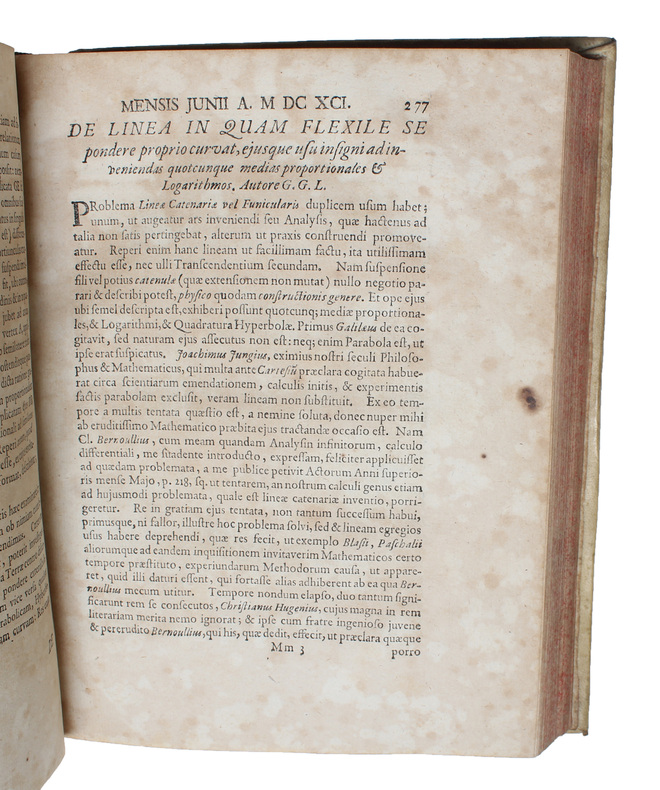
|
|
|
"LOCKYER, JOSEPH NORMAN - THE DISCOVERY OF HELIUM.
Spectroscopic Observations of the Sun.- No. II. Received November 19,- Read November 19 and 26, 1868. (With additional notes Nov. 26, April 9, 1869, Oct. 10, 1869).
(London, Taylor and Sons, 1870). 4to. No wrappers as extracted from ""Philosophical Transactions"" 1869, Vol. 159 - Part I. Pp. 425-444 and 2 lithographed plates (1 with the spectrum of helium, 1 with his spectroscope (not requiring eclipses to function)). Clean and fine.
書籍販売業者の参照番号
: 42423
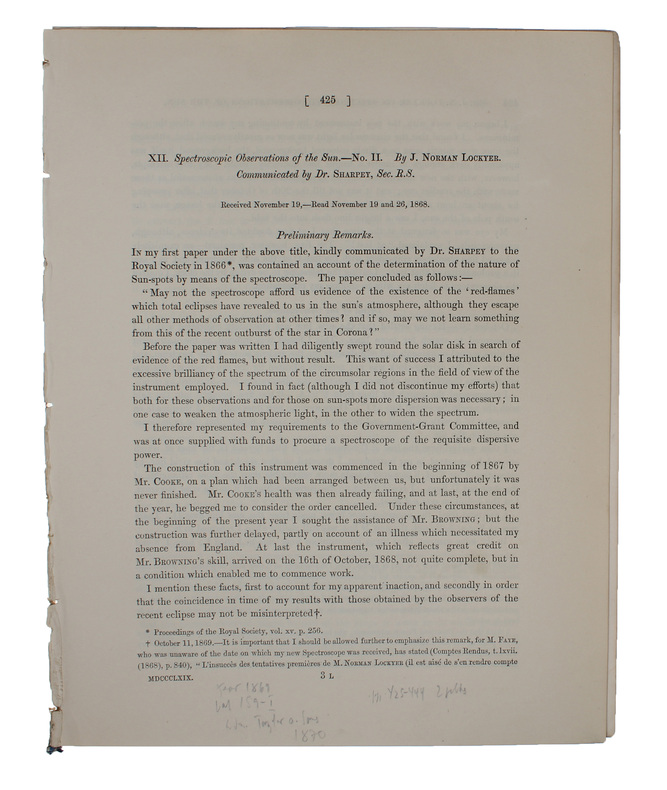
|
|
|
"LOMONOSOW (LOMONOSOV), MICHAELE (MIKHAIL). - THE DISCOVERY OF THE TRANSITION OF A METAL INTO PASSIVE STATE.
Dissertatio de Actione Menstruorum Chymicorum in Genere. (Considerations of the Action of chemical Solvents).
(Petropoli (St. Petersbourg), 1750). 4to. Uncut, without wrappers. Extracted from ""Novi Commentarii Academiae Scientiarum Imperialis Petropolitanae"", Tom. I. ad Annum 1747 et 1748. Pp. 245-266 a. 1 engraved plate (ad. p. 251). Clean and fine.
書籍販売業者の参照番号
: 42895
|
|
|
"MARIGNAC, C. (JEAN CHARLES). - THE DISCOVERY OF THE RARE EARTH YTTERBIUM.
Sur l'ytterbine, nouvelle terre contenue dans la gadolinite.
(Paris, Gauthier-Villars), 1878. 4to. No wrappers. In: ""Comptes Rendus Hebdomadaires des Séances de L'Academie des Sciences"", Tome 87, No 17. Pp. (570-) 616. (Entire issue offered). Marignac's paper: pp. 578-581.
書籍販売業者の参照番号
: 48210
|
|
|
"MATTEUCCI, CARLO. - THE DISCOVERY OF THE ""CURRENT OF INJURY"" AND THE ""CURRENT OF REST"".
Note sur les phénomenes électriques des animaux""
(Paris, Bachelier), 1841. 4to. No wrappers. In: ""Comptes Rendus Hebdomadaires des Séances de L'Academie des Sciences"", Tome XIII, No. 10. Pp. (487-) 558. (Entire issue offered). Matteucci's paper: pp. 540-41.
書籍販売業者の参照番号
: 47143
|
|
|
"MÜLLER, JOHANNES & THEODOR SCHWANN. - THE DISCOVERY OF PEPSIN, THE FIRST KNOWN ANIMAL ENZYME & THE ""FIBRES OF REMAK""
Versuche über die künstliche Verdauung des geronnenen Eiweisses (Müller & Schwann) (+) Ueber das Wesen des Verdauungsprocesses (Schwann). 2 paers.
Berlin, G. Eichler, 1836. In ""Archiv für Anatomie, Physiologie und Wissenschaftliches Medicin Herausgegeben von Johannes Müller"". Jahrgang 1836. Pp. 66-89 a. pp. 90-139. The entire volume offered in its 6 parts (in 5), all 5 issues uncut with orig. printed warppers. (2),CCXXIV,390 pp. and 15 engraved plates. The 2 first issues with a faint dampstain to lower part of leaves and plates.
書籍販売業者の参照番号
: 45406
|
|
|
"NILSON, L.- F. (LARS FREDRIK). - THE DISCOVERY OF A NEW ELEMENT SCANDIUM.
Sur l'ytterbine, terre nouvelle de M. Marignac. (+) Sur le scandium, élément nouveau.
(Paris, Gauthier-Villars), 1879. 4to. No wrappers. In: ""Comptes Rendus Hebdomadaires des Séances de L'Academie des Sciences"", Tome 88, No 12. Pp. (625-) 676. (Entire issue offered). Nilson's papers: pp. 642-645 a. 645-648. First leaf with a tear to right margin, no loss of paper.
書籍販売業者の参照番号
: 47273
|
|
|
"PASTEUR, (LOUIS) et (JULES) JOUBERT - THE FIRST DOCUMENTED DISCOVERY OF AN ANTIBIOTIC.
Charbon et septicémie.
(Paris, Gauthier-Villars), 1877. 4to. No wrappers. In: ""Comptes Rendus Hebdomadaires des Séances de L'Academie des Sciences"", Tome 85, No 3. Pp. (101-) 168. (Entire issue offered). Pasteur & Joubert's paper: pp. (101-) 115.
書籍販売業者の参照番号
: 48136
|
|
|
"PASTEUR, (LOUIS). - THE DISCOVERY OF ANAEROBIC LIFE.
Animalcules infusoires vivant sans gaz oxygène libre et déterminant des fermentations.
(Paris, Mallet-Bachelier), 1861. 4to. No wrappers. In: ""Comptes Rendus Hebdomadaires des Séances de L'Academie des Sciences"", Tome 52, No 8. Pp. (321-) 368. (Entire issues offered). Pasteur's paper: pp. 344-347. Minor marginal brownspots.
書籍販売業者の参照番号
: 53357
|
|
|
"PASTEUR, LOUIS. - ANNOUNCING THE DISCOVERY OF ""MOLECULAR ASSYMETRY""
Mémoire sur la relation qui peut exister entre la forme cristalline et la composition chimique, et sur la cause de la polarisation rotatoire"" (Extrait). (Séance du Lundi 22 Mai 1848).
(Paris, Bachelier), 1848. 4to. No wrappers. In: ""Comptes Rendus Hebdomadaires des Séances de L'Academie des Sciences"", Tome 26, No 21. Pp. (529-) 548. (Entire issue offered). Pasteur's paper: pp. 535-538.
書籍販売業者の参照番号
: 47149
|
|
|
"PASTEUR, LOUIS. - ANNOUNCING THE DISCOVERY OF ""MOLECULAR ASSYMETRY""
Mémoire sur la relation qui peut exister entre la forme cristalline et la composition chimique, et sur la cause de la polarisation rotatoire"" (Extrait). (Séance du Lundi 22 Mai 1848).
(Paris, Bachelier), 1848. 4to. No wrappers. In: ""Comptes Rendus Hebdomadaires des Séances de L'Academie des Sciences"", Tome 26, No 21. Pp. (529-) 548. (Entire issue offered). Pasteur's paper: pp. 535-538. Clean and fine.
書籍販売業者の参照番号
: 49456
|
|
|
"PASTEUR, LOUIS. - DISCOVERY OF ""MOLECULAR ASSYMETRY""
Recherches sur les relations qui peuvent exister entre la forme cristalline, la composition chimique et le sens de la polarisation rotatoire. (+) Note sur la Cristallisation du soufre. (Memoir on the relation that can exist between crystalline form an...
Paris, Victor Masson, 1848 a. 1851. 8vo. 2 contemp. hcalf, raised bands, gilt spine. Light wear along edges. Small stamps on verso of titlepages and on verso of 1 plate. In ""Annales de Chimie et de Physique"", 3me Series - Tome XXIV and XXXI. (6),512 pp. and 2 plates + 512 pp. a. 4 plates.(2 entire volumes offered). Pasteur's papers: pp. 442-459 a. pp. 459-460, 1 double-page folded engraved plate + pp. 67-102 a. 1 plate. Some scattered brownspots to first part of the first volume, not affecting P's papers.
書籍販売業者の参照番号
: 49336
|
|
|
"PAYEN, A. et J.F. PERSOZ - DISCOVERY OF THE FIRST ENZYME, DIASTASE.
Mémoire sur la diastase, les principaux produits de ses réactions et leurs applications aux arts industriels"" (Memoir on diastase, the principal products of its reactions, and their applications to the industrial arts),
Paris, Crochard, 1833. Contemp. hcalf. Raised bands, gilt spine with gilt lettering. A few scratches to spine. Stamps to verso of titlepage. In: ""Annales de Chimie et de Physique, Par MM. Gay-Lussac et Arago."", Series 2, tome 53. Entire volume offered. 448 pp. Payen & Persoz's paper: pp. 73-92. Clean and fine.
書籍販売業者の参照番号
: 51493
|
|
|
"PELLETIER, PIERRE et JOSEPH CAVENTOU. - THE DISCOVERY OF STRYCHNINE.
Note sur un nouvel Alcali (Lu à l'Academie des Sciences le 10 août 1818. (+) Mémoire Sur un nouvel Alcali végétal (la Strychine) trouvé dans la fève de Saint-Ignace, la noix vomique, etc. (Lu à l'Academie des Sciences le 14 décembre 1818).
(Paris, Crochard, 1818,1819). No wrappers. In: ""Annales de Chimie et de Physique, Par MM. Gay-Lussac et Arago."", tome 8 (Cahier 3) a. 10 ( Cahier 2), pp. 225-336 and pp. 129-240. (Entire issues offered). Pelletier & Caventou's papers: pp. 323-324 (tome 8) and pp. 142-176 (tome 10). A few scattered brownspots.
書籍販売業者の参照番号
: 43871
|
|
|
"PELTIER, JEAN CHARLES A. - DISCOVERY OF THE ""PELTIER-EFFECT""
Nouvelle Expériences sur la Caloricité des courans électriques.
(Paris, Crochard, 1834). No wrappers. In: ""Annales de Chimie et de Physique"", 2. Series, Tome 56, Cahier 4 (last issue of tome 56). Entire issue offered. Pp. 337-444. Peltier's paper: pp. 371-386. The text calls for a plate, but not present here.
書籍販売業者の参照番号
: 43654
|
|
|
"Pierre Valière"
"Le voyage de Magellan raconté par un homme qui fut en sa compagnie"
"1976. Paris Centro Cultural Portugués Fundaçao Calouste Gulbenkian 1976 - Cartonné 19 cm x 25 5 cm 214 pages + 6 planches hors-texte - Edition critique traduction et commentaire du texte manuscrit (fac-similé) recueilli par Fernando Oliveyra de Pierre Valière préface de Paul Teyssier notes importante bibliographie tableau comparatif des récits de Pigafetta Bautista et du MS de Leiden - Très bon état"
書籍販売業者の参照番号
: 13091
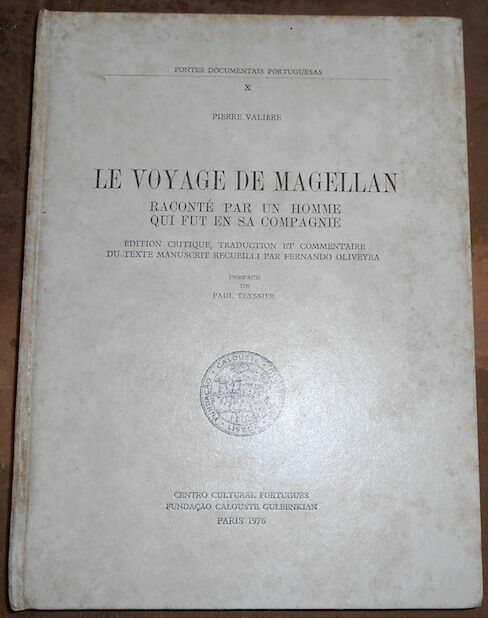
|
|
|
"PIRIA, RAFFAELE. - THE DISCOVERY OF SALICIN - ASPIRIN.
Recherches sur la Salicine et les produits qui en dérivent.
Paris, Bachelier, 1839. 4to. No wrappers. In: ""Comptes Rendus Hebdomadaires des Séances de L'Academie des Sciences"", Tome VIII, No 13. Pp. (459-) 504. (Entire issue offered). Piria's paper: pp. 479-485.
書籍販売業者の参照番号
: 47232
|
|
|
"PLÜCKER, (JULIUS). - THE DISCOVERY OF CATHODE RAYS.
Ueber die Constitution der elektrischen Spectra der verschiedenen Gase und Dämpfe. (+) Nachtrag zu der Abhandlung über die Consstitution der elektrischen Spectra der verschiedenen Gase und Dämpfe. (2 papers).
Leipzig, Johann Ambrosius Barth, 1859. Without wrappers as issued in ""Annalen der Physik und Chemie. Hrsg.von Poggendorff"", Bd. 107, Viertes Stück.(= Heft No. 8 of 1859). (The entire issue offered (Heft 4 of vol. 107 with titlepage to vol. 107). Pp. 497-660. - Plücker's papers: pp. 497-539 a. 638-643. Clean and fine.
書籍販売業者の参照番号
: 43325
|
|
|
"POINCARE, H. (HENRI). - THE DISCOVERY OF AUTOMORPHIC FORMS.
Sur les fonctions fuchsiennes. (+) Sur les fonctions.... Note. (+) Sur les fonctions.... Note.
(Paris: Gauthier-Villars), 1882. 4to. No wrappers. In: ""Comptes Rendus Hebdomadaires des Seances de l'Academie des Sciences"", Vol 94, No 4 + 15 + 17. Pp. (149-) 184, pp. (997--) 1068 a. pp. (1139-) 1214. (3 entire issues offered). Poincare's papers: pp. 163-168, 1038-1042 a. 1166-67.
書籍販売業者の参照番号
: 49173
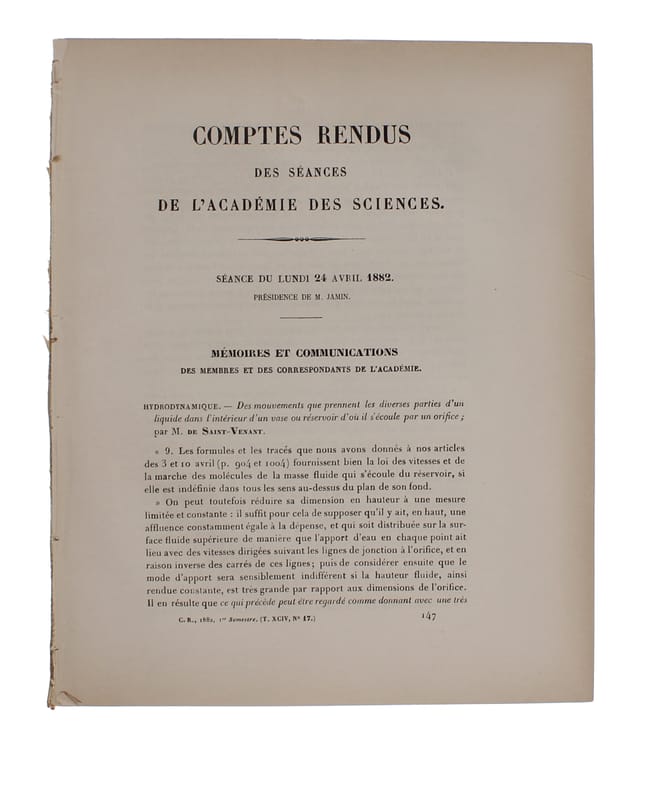
|
|
|
"POINCARÉ, HENRI. - THE DISCOVERY OF AUTOMORPHIC FUNCTIONS
Theorie des Groupes fuchsiens (+) Mémoire sur les Fonctions fuchsiennes (+) Sur les Fonctions de deux Variables (+) Mémoire sur les groupes kleinéens (+) Sur les groupes des équations linéaires (+) Mémoire sur les fonctions zétafuchsiennes. - [THE DISCOVERY OF AUTOMORPHIC FUNCTIONS]
Berlin, Stockholm, Paris, F. & G. Beijer, 1882-84. Large4to (272 x 230 mm). Three volumes uniformly bound in contemporary half calf with gilt lettering to spine. In ""Acta Mathematica"", volume 1-5. Light wear to extremities, boards and spines with scratches. Stamp to verso of front board in all volumes. First three leaves in first volume detached, otherwise internally fine and clean. Vol. I, pp. 1-62" Pp. 193-294 Vol. II, pp. 97-113 Vol. III. pp. 49-92 Vol. IV pp. 201-312" Vol. V pp. 209-278.
書籍販売業者の参照番号
: 60243
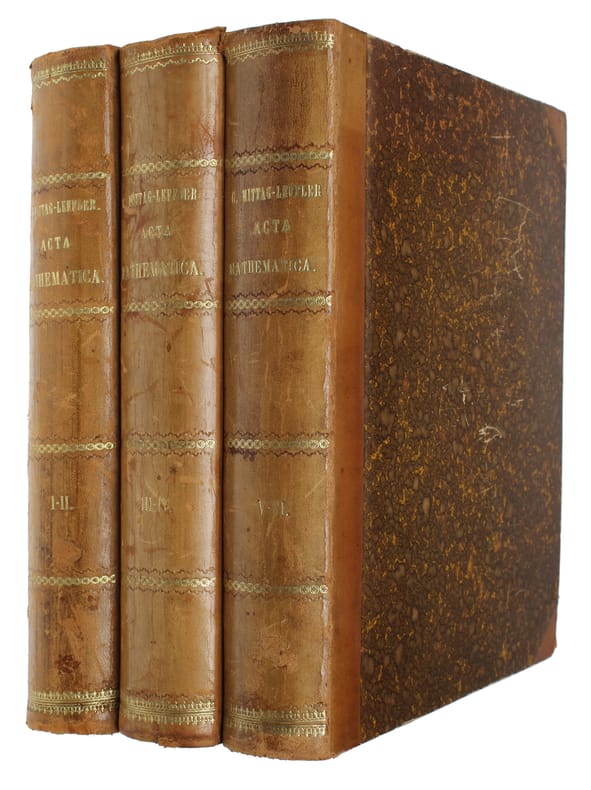
|
|
|
"Pères Baur et Le Roy"
"A Travers le Zanguebar voyage dans l'Oudoé l'Ouzigoua l'Oukwéré l'Oukami et l'Ousagara"
"1893. Tours Éditions Alfred Mame & Fils 1893 3ème ed. - Cartonné percaline rouge tranches dorées 18 5 cm x 27 5 cm 368 pages 45 gravures 1 carte - Texte des Pères Baur et Le Roy - Sur la couv. il est imprimé entre lettres dorées : « Ecole de Jublains Certificat d'Etudes 1896 Gesbert Joseph rousseurs sinon bon état"
書籍販売業者の参照番号
: 15675
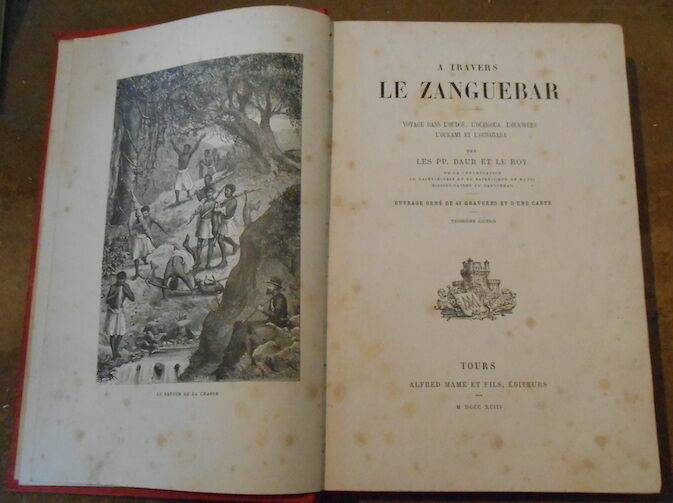
|
|
|
"RAMSAY, WILLIAM & PER THEODOR CLEVE. - THE INDEPENDENTLY DISCOVERY OF HELIUM ON EARTH
On a Gas showing the Spectrum of Helium, the reputed cause of D3, one of the Lines in the Coronal Spectrum. preliminary Note. (Received March 26, 1895). (+) Helium, a Gaseous Constituent of certain Minerals. Part I. And (P.E. CLEVE:) Sur la présence d...
London, arrison and Sons, 1895. - (Paris, Gauthier-Villars), 1895. 8vo. and 4to. Later full cloth, gilt lettering to spine (Ramsay) and without wrappers (Cleve). In ""Proceedings of the Royal Society"" (Ramsay), Vol. 58. (Entire vol. offered). And in ""Comptes Rendus Hebdomadaires des Séances de L'Academie des Sciences"" (Cleve), Tome 120, No 15. Pp. (797-) 850. (Entire issue offered). Ramsay's papers: pp. 65-67 and pp. 81-89. - Cleve's paper: p. 834. Stamps tp edges and a few corners a bit bumped on vol. 58, otherwise clean and fine.
書籍販売業者の参照番号
: 49284
|
|
|
"RAMSAY, WILLIAM and MORRIS W. TRAVERS. - DISCOVERY OF THE ELEMENT KRYPTON.
On a new Constituent of Atmospheric Air. Received June 8 - Read June 9, 1898.
(London, Taylor and Francis, 1898) No wrappers. In ""Proceedings of the Royal Society of London."", Vol.63, Nos. 399-400 (both issues offered).. Pp. 373-480 a. 5 plates. Ransay & Travers' paper: pp. 405-408.
書籍販売業者の参照番号
: 44238
|
|
|
"RAOULT, F.-M. (FRANCOIS MARIE). - DISCOVERY OF RAOULT'S LAWS.
Loi générale de congélation des dissolvants, Mémoire de... (Extrait par l'auteur). (+) Loi générale des tensions de vapeur des dissolvants. (2 Papers).
(Paris, Gauthier-Villars), 1882. 4to. No wrappers. In: ""Comptes Rendus Hebdomadaires des Séances de L'Academie des Sciences"", Tome 95, No 22 a. Tome 104 No 21 (entire issues offered). Pp. 1017-1076 and pp. 1387-1462. Raoult's papers: pp. 1030-33 (tome 95) and pp. 1430-1433 (tome 104).
書籍販売業者の参照番号
: 47024
|
|
|
"RAYLEIGH, LORD (J.W. STRUTT) and WILLIAM RAMSAY. - THE DISCOVERY OF ARGON.
Argon, a New Constituent of the Atmosphere. Received and Read January 31, 1895.
(London, Harrison and Sons, 1895). 4to. No wrappers as extracted from ""Philosophical Transactions"", Vol. 186 - I, Series A. Pp. 187-241 a. 8 textillustrations (apparatus). Fine and clean.
書籍販売業者の参照番号
: 42221
|
|
|
"RAYLEIGH, LORD (J.W. STRUTT) and WILLIAM RAMSAY. - THE DISCOVERY OF ARGON.
Argon, a New Constituent of the Atmosphere. Received and Read January 31, 1895.
London, Harrison and Sons, 1895. 4to. Orig. full cloth. Gilt lettering to spine. Blindtooled covers. First corner a bit bumped. In ""Philosophical Transactions"", Vol. 186 - I, Series A. XIV,(2),602,(4) pp. (Entire volume offered). The paper: p. 187-241 a. 8 textillustrations (apparatus). The title-page with faint brownspots. Otherwise internally clean and fine.
書籍販売業者の参照番号
: 49207
|
|
|
"RITTER, (JOHANN W.). - THE DISCOVERY OF ""CHEMICAL RAYS"" - ULTRAVIOLET LIGHT AND RADIATION.
Announcing his discovery of ultraviolet light ""Von den Herren Ritter und Bückmann. - - Am 22sten Febr. habe ich auch auf der Seite des Violetts im Farbespectrum, ausserhalb desselben, Sonnenstrahlen angetroffen....
Halle, Rengerschen Buchhandlung, 1801. Without wrappers as published in ""Annalen der Physik. Herausgegeben von Ludwig Wilhelm Gilbert"", Bd. 7, Viertes Stück. The entire issue offered (=Heft 4). Pp. 387-528. Ritter's announcement p. 525. With titlepage to volume 7. Clean and fine. Titlepage a bit shavedin inner margin.
書籍販売業者の参照番号
: 43492
|
|